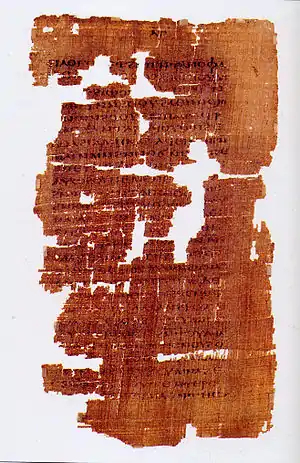First Apocalypse of James
The First Apocalypse of James is an early third century Gnostic apocalypse.[1]
 |
Authorship
One of the most curious features of the First Apocalypse of James is that the range of dating of its original text, assigned to it by scholars, requires that it was written after the Second Apocalypse of James.
Contents
The form of the text is primarily that of a Revelation Dialogue/Discourse between James the brother of Jesus (James the Just) and Jesus, with a rather fragmentary account of the departure (possibly meaning martyrdom) of James appended to the bottom of the manuscript, connected to the remainder by an oblique reference to crucifixion. The first portion of the text describes James' understandable concern about being crucified, whereas the latter portion describes secret "passwords" given to James so that he can ascend to the highest heaven (out of 72) after dying, without being blocked by evil "powers" of the demiurge. In the text, Jesus tells James, "you are not my brother materially."[2]
Some of the framing background details about James given in the text are thought by academics to reflect early traditions; according to the text:
- James was the head of the early church.
- James was the most senior apostle.
Manuscripts
The First Apocalypse of James is regarded as part of the New Testament apocrypha.
Nag Hammadi
It was first discovered amongst 52 other Gnostic Christian texts spread over 13 codices by an Arab peasant, Mohammad Ali al-Samman, in the Egyptian town of Nag Hammadi late in December 1945.
The Nag Hammadi Coptic manuscript is remarkably well preserved for its age; it was reported that the cache of texts called the "Nag Hammadi library", when originally found, were sealed within a large terra cotta vessel. They were secreted during the fourth century, in an effort to hide the texts from destruction by others.[3]
Codex Tchacos
Another copy has more recently been found in the Codex Tchacos,[4][5] where it is merely titled 'James'. Those texts were in the Coptic language.
Oxyrhynchus
In 2017, the first Greek copy was found (the work was originally written in Greek)[6] amongst unpublished Oxyrhynchus Papyri housed at Oxford University.[7]
The first-known Greek copy of the text was discovered in 2017 at Oxford University by Geoffrey Smith and Brent Landau, religious studies scholars at the University of Texas at Austin. The fragments date from the fifth or sixth century and were probably a teacher's model used to help students learn to read and write.[8][9] The fragments will be published in the Oxyrhynchus compilation The Greco-Roman Memoirs.
References
- McDowell, S. (2016). The Fate of the Apostles: Examining the Martyrdom Accounts of the Closest Followers of Jesus. Taylor & Francis. p. 126. ISBN 978-1-317-03190-1. Retrieved 22 June 2018.
- The text begins "It is the Lord who spoke with me: "See now the completion of my redemption. I have given you a sign of these things, James, my brother. For not without reason have I called you my brother, although you are not my brother materially."
- Markschies, Christoph (trans. John Bowden), (2000). Gnosis: An Introduction. T & T Clark. See details at Nag Hammadi library.
- Smith, A.P. (2009). A Dictionary of Gnosticism. Quest Books. p. 60f. ISBN 978-0-8356-0869-5.
- Kasser, R.; Meyer, M.; Wurst, G.; Ehrman, D.; Gaudard, F. (2008). The Gospel of Judas. National Geographic. p. 64f. ISBN 978-1-4262-0048-9. Retrieved 22 June 2018.
- Medrano, Kastalia (2017-11-30). "First Copy of Jesus's Secret Writings to His Brother Recovered From Antiquity in Original Greek". Newsweek. Retrieved 2017-12-04.
Greek, the language in which it was originally written
- Greg Ritchie (4 Dec 2017). "Heretical text of Jesus' brother found in Oxford". Retrieved 9 December 2017.
- "UT Austin Professors Discover Copy of Jesus' Secret Revelations to His Brother" (press release). University of Texas at Austin. 2017-11-29. Retrieved 2017-11-30.
- Ritchie, Greg (2017-12-04). "Heretical text of Jesus' brother found in Oxford". Cherwell. Retrieved 2017-12-05.
Further reading
- Jones, F. S. (1990). The Martyrdom of James in Hegesippus, Clement of Alexandria, and Christian Apocrypha, Including Nag Hammadi: A Study of Textual Relations. In Society of Biblical Literature Seminar Papers (Vol. 29, pp. 323–27).
External links
- Online English text of The First Apocalypse of James
- James M. Robinson, ed., The Nag Hammadi Library, revised edition. HarperCollins, San Francisco, 1990.
- Wilhelm Schneemelcher, ed., translation by R. McL. Wilson, New Testament Apocrypha : Gospels and Related Writings (Louisville: John Knox Press, 1992), pp. 313–326.
